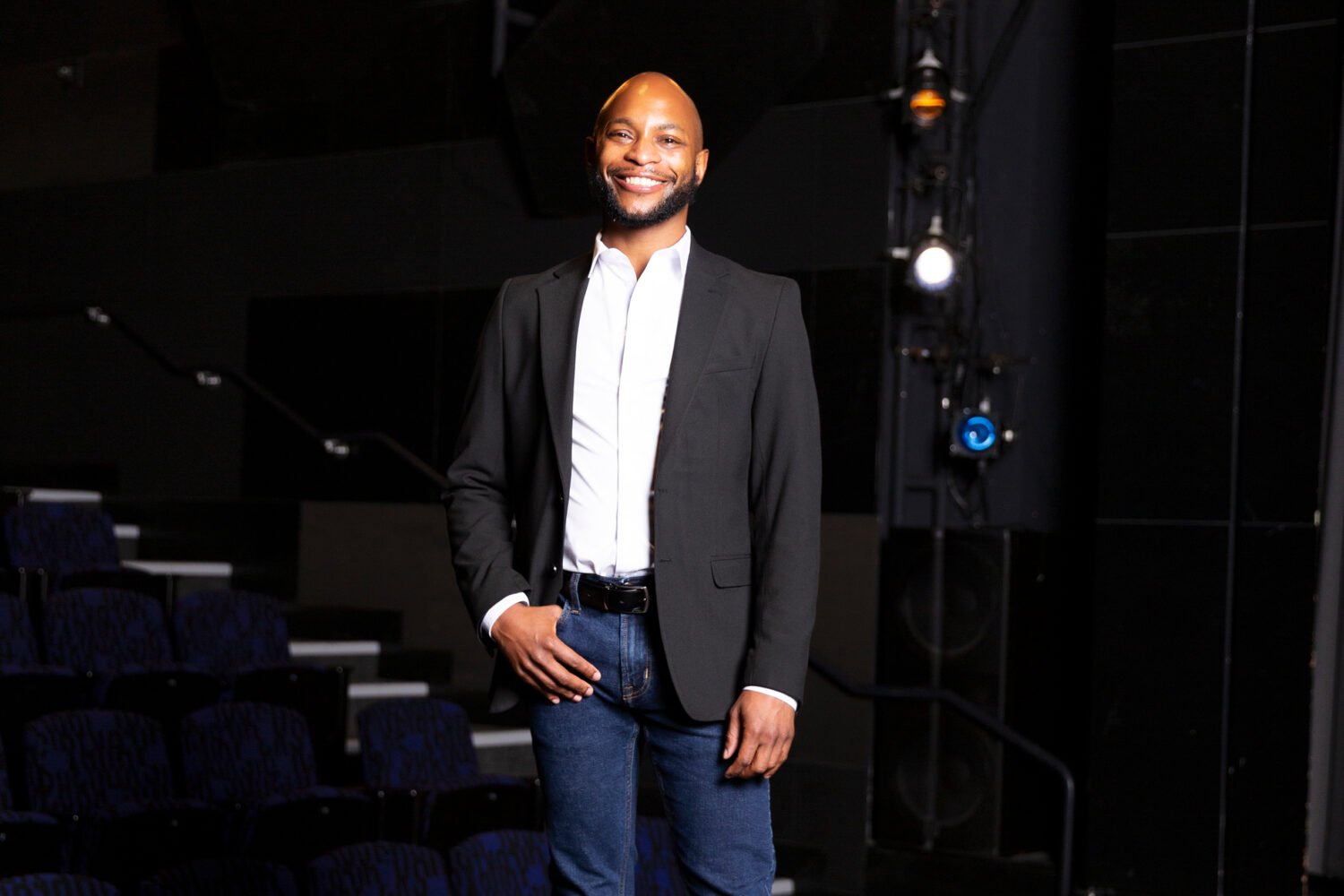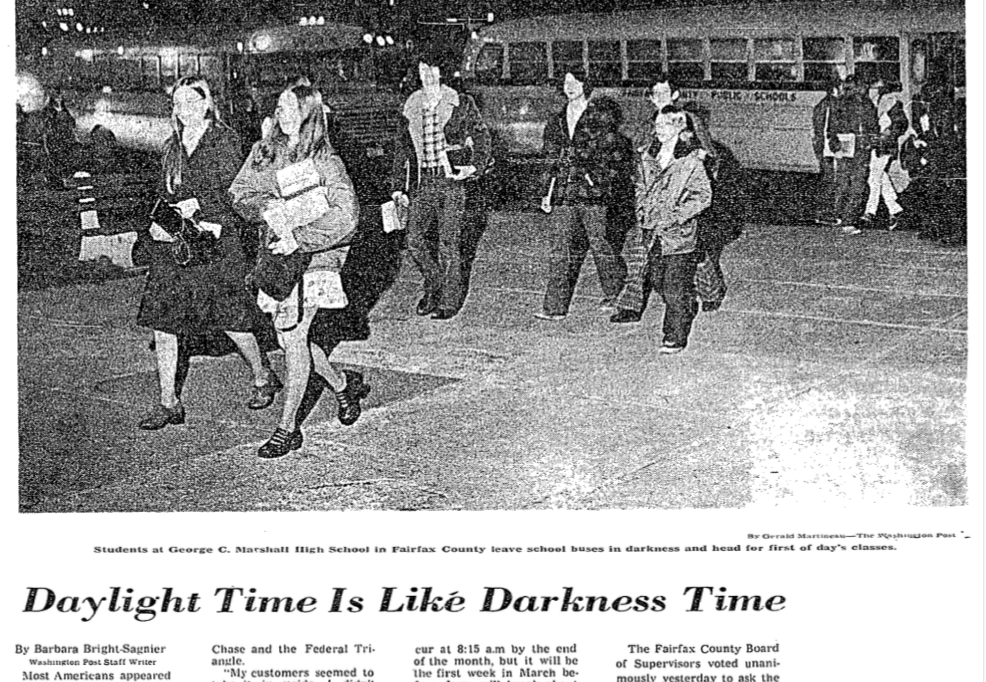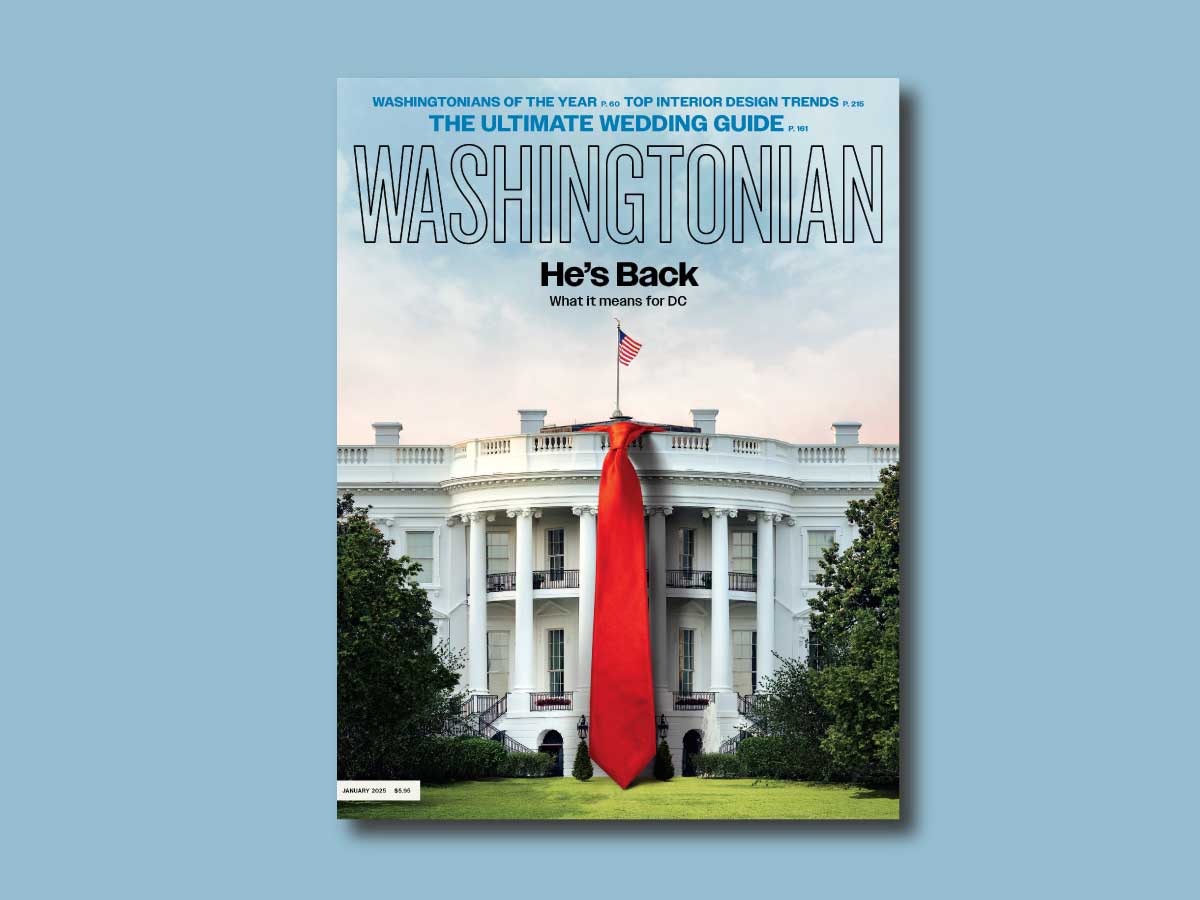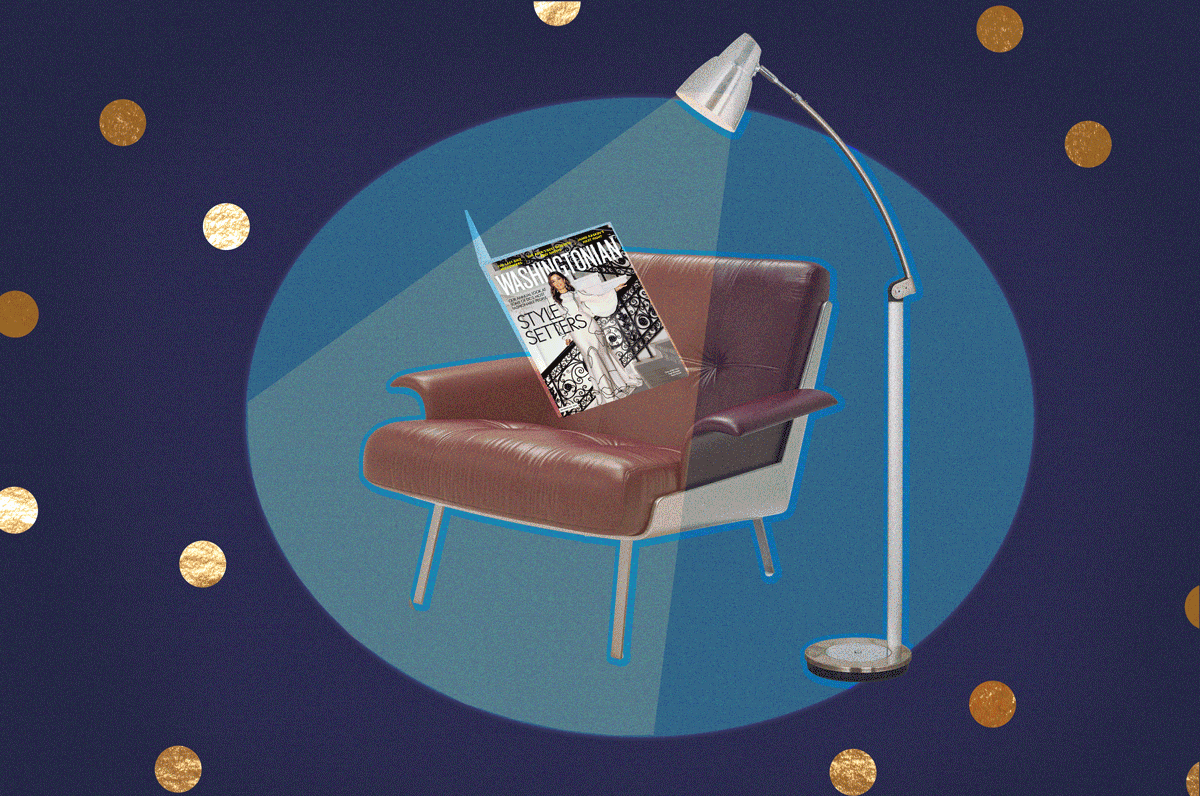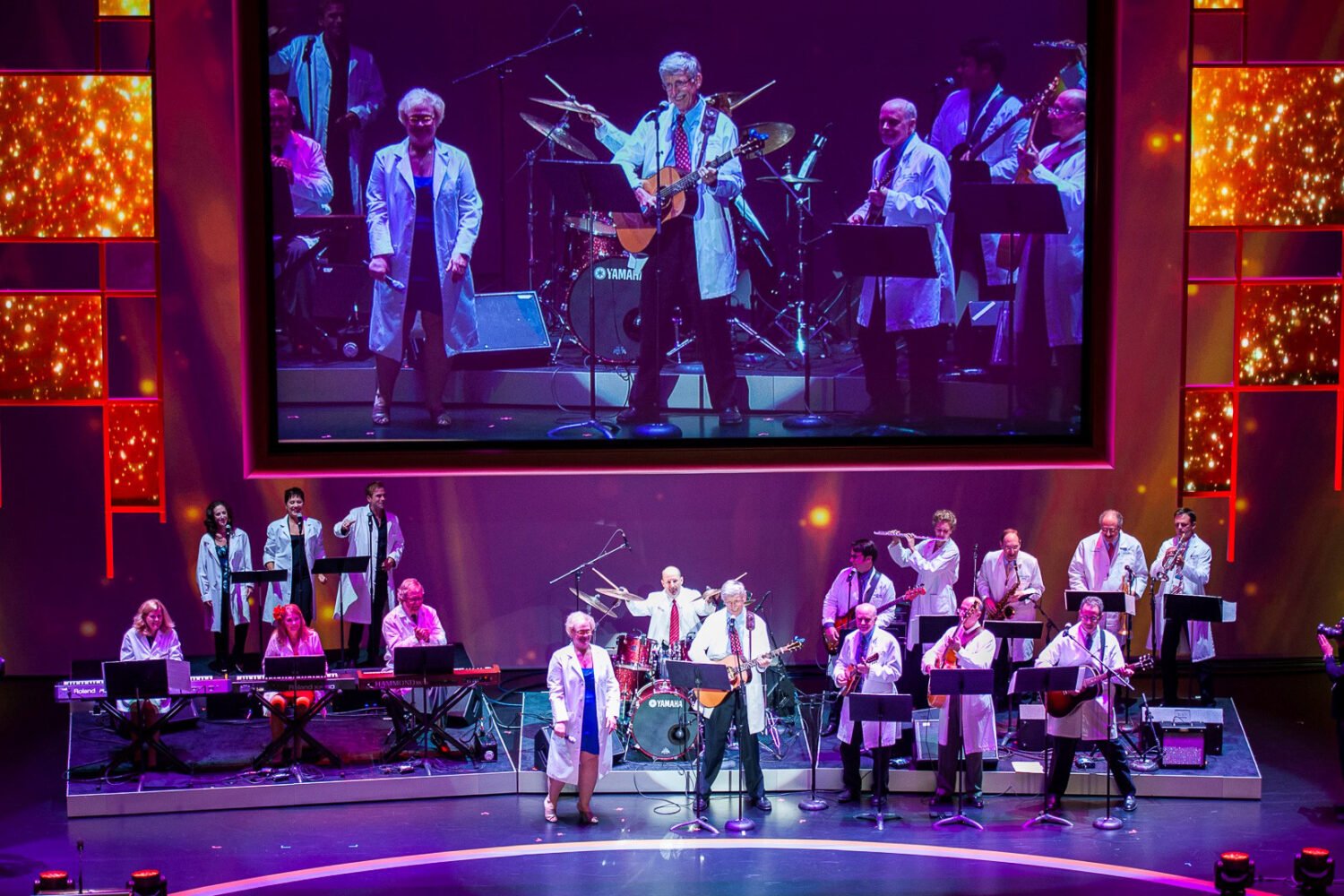Within the blur of a week, the maestro conducted his way through European masterpieces, American symphonic classics, and a contemporary concerto that featured young string soloists who looked like a garage band. He beamed as he led performances by onetime prodigies whose careers he has promoted. Then he played piano accompaniment on three Schubert song cycles and capped an evening by playing the composer’s final piano sonata. Toss in a couple of tough-love master classes with young artists and a little stroking of major donors.
Some week.
Welcome to the world of Christoph Eschenbach—a whirling and creative universe. And buckle your seat belt. By this time next year, Eschenbach, one of the most exciting classical conductors of the day, will be music director of both the National Symphony Orchestra and the Kennedy Center.
He will control a major part of Washington’s classical-music scene—or that part not reigned over by superstar Plácido Domingo as director of the Washington National Opera. As the KenCen’s first-ever music impresario, Eschenbach will be in a position to set the tone for much of what is heard at the region’s top performance venue.
With any luck, Eschenbach, given his intellect and charisma, will rouse the talent within the NSO, a 78-year-old ensemble that has languished outside the ring of the nation’s Big Five orchestras—Boston, Chicago, Cleveland, New York, and Philadelphia.
After a 3½-year reconnaissance, the NSO search committee voted last year to turn to this worldly German with a shaved head and piercing eyes.
Emotionally scarred almost at birth by World War II, Eschenbach became a first-rank solo pianist—he has two discs in Philips’s 200-CD set Great Pianists of the 20th Century—and then one of the most widely recorded classical conductors. After five decades of performing and conducting all over the world—including stints heading orchestras in Germany, Zurich, Houston, Paris, and Philadelphia—he now has been called to share some of his continental éclat with Washington and the NSO.
“ ‘Underachiever’ is not the right word” for the NSO, says Roger Sant, a member of the orchestra’s board of directors, “but I think we all feel we can do better.”
“We feel a responsibility that this be a more notorious orchestra than it has been,” says Sant, a former energy mogul who with his wife has given the NSO $20 million over the last decade, including $5 million on the day Eschenbach’s appointment was announced. “I think Eschenbach will put a new twist on it. He’s a cosmopolitan, international maestro, and he wants to leverage the orchestra’s Washingtonian-ness and its symbolism outwardly in the world.”
It will be, at minimum, interesting to watch the NSO as Eschenbach continues his rethinking of the classics and plunges into new work by contemporary composers from around the world.
That could be a needed tonic after the seemingly rudderless final seasons of the NSO’s last music director, Leonard Slatkin. Reports from musicians who took part in Eschenbach’s seven hours of private rehearsals with the NSO in August are encouraging.
Eschenbach’s personal story began on February 20, 1940, when he was born Christoph Ringmann, the son of Margarethe and Heribert Ringmann, a musicologist at the University of Breslau, which at the time was in Germany and now is in Poland. He relates his early years of survival in Ruth Yorkin Drazen’s public-TV documentary A Wayfarer’s Journey: Listening to Mahler: “Like Mahler, my childhood, too, was full of death experiences. My mother died giving birth to me. My father was sent to the war front to be slaughtered in a Nazi punishment battalion.”
Young Christoph was sent to live with a grandmother, but soon they were forced to flee from the Soviet Army’s onslaught: “After a year of flight, she, too, died and I was left a small boy, alone in a refugee camp. So death was all around me and, finally, in myself when I nearly died of typhus.”
He was rescued by Wallydore Eschenbach, a cousin of his mother’s. But his wartime trauma had stunned him into muteness, which lasted almost a year: “The dark impressions, compressed into this small amount of past, were so heavy that a fierce depression closed my soul.”
His redemption lay in music: “My guardian mother asked me a question regarding the wondrous music I heard her play every night and teach every day: ‘Do you want to express yourself in this very music?’ And a very first word came from my lips: ‘Yes.’ ”
He eventually took his adoptive family’s surname—and its passion for music.
While Eschenbach’s tenure will see plenty of modern music, he has been hired in large part to make a return to the core Austro-Germanic symphonic literature—principally Mozart, Beethoven, Brahms—that many felt Leonard Slatkin had slighted.
“Programmatically, I see in the last years a lack of the classical repertoire,” says Eschenbach. As in his previous posts in the United States and Europe, he will continue to knock dust off those classics. Beethoven symphonies, he says, “have to be relentless, in a way, and dramatic and not at all pompous, not at all ponderous.”
This will not be a strain for Eschenbach. “I love drama,” he says. “I think if I wouldn’t have been a musician, I would have been an actor.”
In rehearsal and performance, he says, spontaneity is “totally important. I don’t want the orchestra to be a gray mass. I want them to show personality and give musical opinions not by word but by playing.”
A brass player who’s worked with Eschenbach says there’s “not much chitchat” during rehearsal. But when he gets what he wants from players, he can be ebullient, as illustrated in the PBS film: “Now it’s the right sound. Triumphant! Great! Brilliant! Big! Joyful! Bliss! Heaven! Everything! Thank you very much.”
Eschenbach has what Richard Barber, NSO assistant principal bass and a search-committee member, calls “a sonic vision” that could help the orchestra develop what many of the finest ensembles have—a distinct sound. “Almost the tone of someone’s voice,” Barber says.
“We felt that our sound had become somewhat diffuse and not as cohesive,” he says. “It was being talked about openly.” The musicians, Barber says, are looking to develop a sound that is “conductor-proof” for the half of the concerts that are led by visiting conductors. Otherwise, some authoritarian guests try to force their preferred sound onto the orchestra for the brief time that they’re in town.
Eschenbach comes with strong references from well-known collaborators. Soprano Renée Fleming, who’s worked with Eschenbach more than 20 years, praises his humility and instincts. “He doesn’t lead ever with his ego. That’s probably, right there, something unusual,” Fleming told me in an interview after she and Eschenbach toured Scandinavia this spring with the Orchestre de Paris.
Pianist Lang Lang told a Playbill interviewer that Eschenbach “is truly special, the most sincere musician I have ever known.” Eschenbach gave Lang Lang a break ten years ago by substituting him into a Ravinia Festival gala for an ailing André Watts.
Eschenbach can stir controversy. Some critics don’t like his interpretations, especially the sometimes unorthodox tempos, which can range from super-presto to an exaggerated largo—and can vary from rehearsal to performance.
Eschenbach pays the tempo police no mind: “Nothing should be fixed. We don’t put ourselves in boxes as musicians, and we have not swallowed metronomes.”
Although he can drive an orchestra at frenzied speeds, he often favors a slower pace to draw as much emotion as possible from a score. “Quicker tempos tend to court superficiality,” he has said.
With his free tempos, says Jeffrey Kallberg, chairman of the music department at the University of Pennsylvania and pre-concert lecturer for the Philadelphia Orchestra, Eschenbach “goes back to what was the normal style of conducting before World War II, which was freely changing tempo.”
In Eschenbach performances ranging across 18 works over the late spring and summer this year, the common denominator was passion and expressivity, whether he was conductor, piano soloist, or accompanist.
As the Los Angeles Philharmonic got to the final “damnation” chords in Tchaikovsky’s symphonic poem “Francesca da Rimini” one Sunday afternoon in Walt Disney Concert Hall, Eschenbach drew such intense playing that spontaneous combustion would not have been a surprise.
As the sound died, there was a moment of silence, then an avalanche of applause from the audience. Even Los Angeles Times critic Mark Swed, not wholly convinced by Eschenbach’s interpretation, remarked on the electricity. “Eschenbach wanted a crazy speed just past the safety zone for hairpin turns,” Swed wrote. “It was quite a show.”
A similar intensity emerged with the Chicago Symphony and soloist Nadja Salerno-Sonnenberg at the Ravinia Festival, the orchestra’s summer home. By the concluding wild ride in Shostakovich’s Violin Concerto No. 1, a few licks of flame would not have seemed amiss.
The NSO search focused on such performances and seems to have written off Eschenbach’s rough patch as conductor of the Philadelphia Orchestra, his last major US post before agreeing to become music director of the NSO.
Eschenbach’s five-year tenure, from 2003 to 2008, as music director of what has been known as the Fabulous Philadelphians, was the shortest in the orchestra’s century-plus existence. Eugene Ormandy lasted 44 years (1936–80), and his immediate predecessor, Leopold Stokowski—with whom he overlapped by five years—had the job for 29 (1912–41).
The circumstances of Eschenbach’s departure are clouded, though there’s little doubt his tenure was tumultuous. Eschenbach says he departed voluntarily after leaders of the Philadelphia Orchestra Association lied to him about the players’ desire for him to move on. At issue is whether there was an orchestral vote of confidence in him and, if so, what the result was.
“They said there was a survey of the whole orchestra and more than 80 percent of the orchestra was against me,” Eschenbach says. “I asked the management was that true and was told, ‘Yes, it’s true.’
“It was not true at all. As I found out a little later, this survey never happened.
“There are always a few musicians in the orchestra who are against conductors. This also creates a quite interesting dynamic—but not that percentage, by far not. All of the musicians regretted very, very much that was reported like this.”
The controversy over Eschenbach’s leadership was such that the two classical-music critics of the Philadelphia Inquirer wrote dueling columns about whether the maestro should stay or go. One was headlined call it quits: start search now for a harmonious match. The other was keep him: his personal music-making is a treasure.
At the time of Eschenbach’s departure, the orchestra’s president, James Undercofler, was reported as saying: “We had very broad-ranging discussions, and as a result of those discussions came this decision.”
The chairman of the players’ artistic committee, trumpeter David Bilger, told the Inquirer that Eschenbach’s departure was “a bit of a surprise. Most people were expecting the announcement of some kind of extension” of Eschenbach’s tenure.
Whatever the case, Eschenbach got the Philadelphians their first recording contract in ten years and led them on successful tours, including one this year after he officially severed his ties. He also has been invited back for guest conducting.
Might the orchestra now regret Eschenbach’s departure? LA Times critic Mark Swed asked earlier this year if the “financially troubled, leaderless, possibly humbled ‘Fabulous’ Philadelphians have perhaps realized what they lost.”
Eschenbach’s edginess clearly appealed to the NSO’s search committee.
“We didn’t pick anybody safe,” says NSO executive director Rita Shapiro. “He will probably rattle some cages. But that’s what we want.”
That will not be a problem for Eschenbach. “Risk taking with precision is good,” he says. A London critic three years ago, after a Philadelphia Orchestra visit there, called it “Eschenbach’s calculated spontaneity.”
“Music is about freedom,” Eschenbach says—an orchestra should not “play just the result of the last rehearsal. Of course we play the last rehearsal, but on top of it we put ideas which come into reality” during a performance.
“When I study a score, I want to find new things every day in the score. I want this give and take between conductor and orchestra.”
When Eschenbach’s tenure as the NSO’s music director begins next fall, the orchestra will have been without one for two full seasons. The orchestra has fared better than many expected under principal conductor Iván Fischer, who was always considered a fill-in, if only because of a long-range commitment in his native Hungary. But the arrival of a leader with some hope of continuity—and a touch of old-fashioned showmanship—is overdue.
Most of America’s Big Five orchestras have traditions of engaging European conductors. From the late 1840s until Leonard Bernstein took over in 1958, the New York Philharmonic had only foreign-born music directors. James Levine, who took the helm of the Boston Symphony in 2004, was that orchestra’s first US-born music director.
Philadelphia’s Jeffrey Kallberg says Eschenbach fits superbly into this line of émigrés: “He is a fantastic conductor. He brings a kind of freedom to the tempos that’s part of the important history of conducting . . . something that is a remarkable thing for audiences these days to experience.” Without risks, Kallberg says, “you kind of get tedium in the end.”
Although people from all quarters of the NSO speak courteously of Slatkin, who has moved on to the Detroit Symphony, Eschenbach’s selection was a reaction to what was seen as Slatkin’s slighting of the 19th-century European heart of the standard symphonic repertoire.
“You’re always reacting to what you had before,” says search-committee member Alice Kogan Weinreb, an NSO flutist for 30 years. She recalls the “wonderful, exciting years” in which the Soviet-era dissident Mstislav Rostropovich, perhaps the best cellist of his time, led the NSO. His readings of Russian classics were stunning, but ventures into the remainder of the repertoire could be ho-hum.
Under Slatkin, Weinreb says, “we felt like an American orchestra,” which is not necessarily how a major US orchestra wants to be categorized. “We were looking for a European grounding . . . and we felt we wanted that to be an artistic strength.”
Slatkin, 65, suffered a heart attack in early November while conducting the Rotterdam Philharmonic but is expected to be back on the podium soon. He is scheduled for a guest-conductor engagement with the NSO in January, the first since his departure from Washington.
When Eschenbach took over the Houston Symphony in the late 1980s, he called it a “sleeping beauty.” After three days of working with the NSO in August, he said the Washington ensemble was already a “beauty” that needed no awakening, just some unifying leadership.
Working the NSO through a number of classical selections “confirmed that the orchestra is very responsive and reacts very, very quickly to what I say,” Eschenbach says. The NSO is capable of quick changes in timbre or creation of new musical phrasing—“all these good things.”
Marissa Regni, NSO principal second violinist and cochair of the search committee, says the get-acquainted rehearsals went superbly. “He comes out and he says, ‘I’m so happy to be here—let’s just make music together,’ ” Regni recalls. “That’s automatically to me ‘Okay, we’re a team or a family, we’re collaborators.’ It’s not ‘I’m the great maestro, and you are my subjects.’ There was suddenly this cohesiveness. All of a sudden we were all coming together as a unit.”
Regni was one of five NSO musicians on the search committee for the entire process. During the hunt, they had met privately with Eschenbach. “We talked about everything”—repertoire, touring, recording, modern media—recalls Regni. Also on the committee were six members of the NSO board of directors, led by former NSO chairman Ann Jordan, who shared cochair duties with Regni; two members of the orchestra’s administration; and Kennedy Center president Michael Kaiser.
During Eschenbach’s quiet visits to Washington over the past year, he took part in auditions for several orchestra positions and posed for a photograph that will be used in NSO promotions. He taped a conversation with the NSO’s director of artistic planning, Nigel Boon, that will be posted as a series on the orchestra’s Web site (kennedy-center.org/nso) when the repertoire and soloists for the 2010–11 season are announced in March.
Eschenbach arrived here in August direct from his annual visit to Chicago’s Ravinia Festival, which he led from 1994 through 2003. It was at Ravinia that Eschenbach’s week included conducting, performing, accompanying, coaching, and page turning for Tzimon Barto, an American pianist whose career Eschenbach has championed. He also did some light donor maintenance.
NSO executive director Shapiro says Eschenbach’s “deep knowledge of how the American orchestra system works was definitely a plus.” Translation: Eschenbach understands fundraising. Roger Sant says board members on the search committee were pleased to learn of Eschenbach’s willingness to help raise money: “For all of us, that’s music.”
Although slight in stature, Eschenbach has a podium presence in his Chinese-style jackets—black for the main symphony season and white for summer engagements.
He has an intense gaze—“amazing eyes,” says NSO flutist Alice Weinreb—and a stride that belies his 69 years. Eschenbach is still younger than Lorin Maazel was in 2002, when he began to lead the New York Philharmonic, a job for which Eschenbach was also in contention.
Eschenbach was already so booked up when the Washington deal was struck that he will lead only one series of concerts in the orchestra’s current season, performances of Verdi’s “Requiem” March 11 through 13. He takes up his full duties with the launch of the 2010–11 season at a September 25 gala.
For the main three years of his contract, Eschenbach is to conduct ten subscription series yearly, or just fewer than half of the orchestra’s 21 three-concert classical runs.
Eschenbach’s salary hasn’t been disclosed. Arts-administration sources have speculated that the Kennedy Center music-director post was added in part to justify a multimillion-dollar pay package. KenCen president Kaiser defended this unspecified part of the salary by saying that with Eschenbach “you have a potential to bring in more resources.”
Eschenbach certainly will be paid more than Slatkin, sources say. “It’s a step up—I’ll at least talk about that,” says Sant. “We knew that a person with experience was going to take some money, and so we tried to do a little helping on the board side”—including his own $5-million fillip. “Music was number one, and everything else was a very distant second,” says Sant, a founder of Applied Energy Sources, which as AES became one of the world’s largest independent producers of power.
In 2006, according to the most recently available IRS reports, Philadelphia paid Eschenbach’s business arm, Christoforo Inc., $2.3 million, while Slatkin was paid $1.2 million by the Kennedy Center.
Since 1986, the NSO has been an “artistic affiliate” of the Kennedy Center. John Bence, with the League of American Orchestras, says only one other major US orchestra has a similar arrangement, the Atlanta Symphony, which is allied with the Woodruff Arts Center.
Eschenbach’s role in Kennedy Center programming beyond the NSO is still being worked out, but he describes the multiple-hall venue as “a very good forum for interplay of the arts—music, fine arts, dance.”
Kennedy Center president Kaiser says Eschenbach first will advise on the center’s international festivals, one of which is planned for each of the three years of the conductor’s initial contract. “We really need advice and discussion on the classical-music component” of the festivals, says Kaiser. “Those have been the weakest part.”
Glimpses of Eschenbach’s style and sound are available in videos, DVDs, and recordings. His conducting style ranges widely. A YouTube video shows him leading the Orchestre de Paris through almost all of Ravel’s “Boléro” with arms at his side and signaling instrumental entrances only with a tilt of his head or a widening of his dark eyes.
“I have eyes—what should I do with eyes other than use them?” he says. They are used repeatedly as a design element on his Web site, christoph-eschenbach.com.
Eschenbach can be flamboyant, even reminiscent of Leonard Bernstein, one of his mentors. Eschenbach has acknowledged the primacy in his training of two maestros, Herbert von Karajan, the electrifying Austrian, and George Szell, the Old World transplant to Cleveland.
“Szell drew while Karajan painted,” Eschenbach says on his Web site. Is Eschenbach a drawer or painter? “I do both,” he replies.
NSO bassist Barber agrees that Eschenbach can be both sorts of artist and calls his conducting “an interesting paradox.”
“When he’s on the podium, there’s a burning intensity, especially in his eyes,” Barber says. “But at the same time there’s a physical restraint to what he’s doing.”
The first major conductor Eschenbach saw, when he was ten years old, was Wilhelm Furtwängler: “I was so impressed that a man . . . can make musicians play like devils and angels in the same time.” When he told his adoptive mother he wanted to be a conductor, she said he would have to take up an orchestral instrument. “And the next week I had a violin and a violin teacher.” He was already an accomplished keyboard performer.
There may be reflections of Eschenbach’s early years in the way he approaches professional relationships.
Barber says that during repeated exposure to Eschenbach over two decades, he has come to believe that “when he feels safe, he opens up a lot. I do get the sense that if things are not safe and comfortable, then he withdraws.”
Says the NSO’s Sant: “He’s an odd combination of shy and gregarious.”
Eschenbach has spoken about his need for intense reflection. “I make the time, and I must have it every day, the time where I create a space around me and in me where I can meditate freely—above thinking,” he says.
One group Eschenbach seems to feel comfortable with is modern composers, and the feeling—intense admiration, actually—is reciprocated.
“He can really reach into the center and core of a piece,” says Augusta Read Thomas, whose work has been played by the NSO and conducted by Eschenbach. “I always sit on the edge of my seat thinking, ‘What’s coming next?’ ” Eschenbach is expected to conduct the US premiere of Thomas’s Violin Concerto No. 3, an NSO co-commission, in spring 2011, with Frank Peter Zimmermann as soloist.
Jennifer Higdon, whose new piano concerto the NSO will premiere in December, says of Eschenbach that “there’s something soulful about him that is wonderful. I’m always impressed by his gentleness. You take away a different impression from every conductor, but he cares, he listens.” Eschenbach took Higdon’s Concerto 4-3, a joyful Baroque/jazz/country triple concerto, to Ravinia after leading a performance of it with the Philadelphia Orchestra.
Although the NSO will continue to commission American pieces through the John and June Hechinger Commissioning Fund for New Orchestral Works, Eschenbach is expected to program contemporary European composers, too.
“He has very, very wide tastes,” says NSO artistic-planning chief Boon.
Eschenbach says he plans to “make a statement” in the programming of his first subscription concerts as music director. It likely will include one of Eschenbach’s favorite modern works, a piece by Matthias Pintscher—a 38-year-old German who has been called “a radical conservative”—as well as a classical warhorse.
NSO flutist Alice Weinreb says Eschenbach, who was in and out of the nation’s capital throughout the election season of 2008, “seemed thrilled with the idea of being in Washington—that this should be a great orchestra in a great town in a great country.”
Eschenbach was pleased by the election of Barack Obama. “I like to be part of politics if the politics is human,” he says, “and to be frank, I see that with your—our, because I’m a resident of this country—President.”
During his 11 years in Houston from 1988 to 1999, Eschenbach got along well in the back yard of the Bush dynasty. Instead of the dustup in Philadelphia, the NSO search committee seemed to pay more attention to Eschenbach’s widely praised tenure with the Houston Symphony, where players on the Washington committee have friends.
“A lot of them speak of it as the most exciting musical experience of their lives,” says Weinreb. “They just were ecstatic about him. There was no question that musically it was a perfect match for them. It was what they wanted and needed at the time. That’s what our dream is—that it will be that kind of collaboration.”
When Eschenbach announced in 1997 that he would leave the Houston podium, Houston Chronicle music critic Charles Ward said the departing maestro had “built the artistic standards of the orchestra far beyond anyone’s expectations.”
Betsy Cook Weber, director of undergraduate choral studies at the University of Houston and former associate director of the Houston Symphony Chorus, says she reveres Eschenbach as “a profound artist.”
“He always had an original view of the music,” Weber says. “There was always something interesting happening with Christoph. Sometimes it would be a little weird, but it was never, ever boring and usually it was simply riveting.”
As for his sometimes unorthodox approach, Weber recalls a Houston wind player who at Eschenbach’s departure remarked: “We all would follow him off a cliff—and sometimes we did.”
Elyse Lanier, wife of a former Houston mayor and a social mover and shaker, recalls turning to Eschenbach at a small dinner and asking: If he could do anything, what would it be?
Take the symphony to the top of one of Houston’s skyscrapers, Eschenbach said. Before the night was over, Lanier had set the wheels in motion for Power of Houston, an arts extravaganza that saw the city’s skyline bathed in a brilliant light show that accompanied music and dance performances.
Such spectaculars no doubt will occur here. One of Eschenbach’s favorite writers, the 20th-century Austrian Thomas Bernhard, says early in his memoirs, “As in everything else I undertook, I persevered to the very limit.”
The same might be said of Eschenbach.
Wielding the Baton
The National Symphony Orchestra’s music directors have been known as much for their private lives, social climbing, and political battles as for their music making.
Rotterdam-born Hans Kindler left the first-chair cellist job at the Philadelphia Orchestra to found the NSO and led it for 18 years, from the depths of the Depression into the beginning of the boom following World War II. He gets points for perseverance but is remembered as an abrasive presence on and off the podium.
Another cellist, Howard Mitchell picked up the baton and began a 20-year tenure that included the NSO’s first international tour, to Latin America. But his era is perhaps best known for its mediocrity—“the artistic nadir of the National Symphony,” wrote critic and author Ted Libbey. Mitchell seemed as interested in the party circuit as in the rehearsal hall.
Antal Doráti, a Budapest native who studied with Zoltán Kodály and Béla Bartók, rode to the rescue after a virtually bankrupt NSO was hit with a musicians’ strike. He’s credited with rebuilding the orchestra into a serious group of talented performers and putting the NSO on its current professional path.
Mstislav Rostropovich, one of the 20th century’s top cellists, became leader of the NSO three years after emigrating from the Soviet Union in response to decades of official harassment prompted by his outspoken calls for artistic freedom. Appointment of the irrepressible “Slava” was as much a political statement as a shrewd musical move.
A child of musical Hollywood, Leonard Slatkin passed through Washington as he orbited outside the orchestral Big Five, although he led the Cleveland Orchestra’s summer Blossom Festival. Slatkin seemed to lose interest during his National Symphony tenure, perhaps distracted by fallout from an affair with a much younger British musician, including graphic e-mails disclosed in her divorce case.
Iván Fischer, interim National Symphony Orchestra chief as principal conductor, remains anchored in his native Hungary, where he founded the innovative Budapest Festival Orchestra in 1983 and is still its head. His focus there has meant only brief leadership attachments elsewhere, including three years as music director of the Opéra National de Lyon.
Eschenbach at a Glance
1940: Born Breslau, Germany (now Wroclaw, Poland).
1946: Rescued by his mother’s cousin from refugee camp in Mecklenburg, East Germany.
1948: Settles with adoptive family in West Germany.
1951: Awarded first prize, Steinway Young Pianist competition in Germany.
1955: Enters music school, Cologne.
1962: Wins German Radio Competition, Munich.
1964: First recording (Mozart) with Deutsche Grammophon.
1965: Wins Clara Haskil International Piano Competition, Switzerland.
1967: First conducting lessons with George Szell.
1969: US debut as pianist, Cleveland Orchestra with Szell.
1972: Conducting debut (Bruckner’s Third Symphony), Hamburg.
1975: US conducting debut, San Francisco.
1978: Named music director, Staatsphilharmonie Rheinland-Pfalz, Ludwigshafen, Germany.
1982–86: Chief conductor, Tonhalle Orchestra, Zurich.
1988–99: Music director, Houston Symphony.
1994–2003: Music director, Ravinia Festival, summer home of Chicago Symphony.
1998–2004: Chief conductor, NDR (North German Radio) Symphony, Hamburg.
1999–2002: Artistic director, Schleswig-Holstein Music Festival.
2000–10: Music director, Orchestre de Paris.
2003–08: Music director, Philadelphia Orchestra.
2005:Conducts his first cycle of Wagner’s Der Ring des Nibelungen, Théâtre du Châtelet, Paris.
2008: Engaged as music director, National Symphony Orchestra, for three seasons, beginning 2010–11.
This article first appeared in the December 2009 issue of The Washingtonian. For more articles from that issue, click here.



